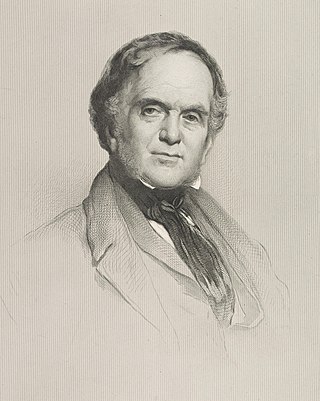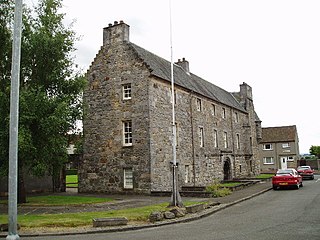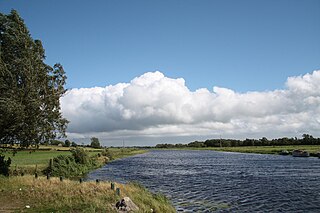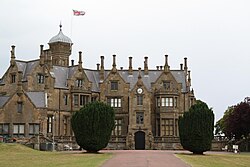
The National is the national art gallery of Scotland. It is located on The Mound in central Edinburgh, close to Princes Street. The building was designed in a neoclassical style by William Henry Playfair, and first opened to the public in 1859.

Castle Douglas is a town in Dumfries and Galloway, Scotland. It lies in the lieutenancy area of Kirkcudbrightshire, in the eastern part of Galloway, between the towns of Dalbeattie and Gatehouse of Fleet. It is in the ecclesiastical parish of Kelton.

Castles have played an important military, economic and social role in Great Britain and Ireland since their introduction following the Norman invasion of England in 1066. Although a small number of castles had been built in England in the 1050s, the Normans began to build motte and bailey and ringwork castles in large numbers to control their newly occupied territories in England and the Welsh Marches. During the 12th century the Normans began to build more castles in stone – with characteristic square keep – that played both military and political roles. Royal castles were used to control key towns and the economically important forests, while baronial castles were used by the Norman lords to control their widespread estates. David I invited Anglo-Norman lords into Scotland in the early 12th century to help him colonise and control areas of his kingdom such as Galloway; the new lords brought castle technologies with them and wooden castles began to be established over the south of the kingdom. Following the Norman invasion of Ireland in the 1170s, under Henry II, castles were established there too.

Belton House is a Grade I listed country house in the parish of Belton near Grantham in Lincolnshire, England, built between 1685 and 1687 by Sir John Brownlow, 3rd Baronet. It is surrounded by formal gardens and a series of avenues leading to follies within a larger wooded park. Belton has been described as a compilation of all that is finest of Carolean architecture, said to be the only truly vernacular style of architecture that England had produced since the Tudor period. It is considered to be a complete example of a typical English country house; the claim has even been made that Belton's principal façade was the inspiration for the modern British motorway signs which give directions to stately homes.
Lurgan is a town in County Armagh, Northern Ireland, near the southern shore of Lough Neagh. Lurgan is about 18 miles (29 km) south-west of Belfast and is linked to the city by both the M1 motorway and the Belfast–Dublin railway line. It had a population of about 28,634 at the 2021 UK census and is within the Armagh, Banbridge and Craigavon district. For some purposes, Lurgan is treated as part of the "Craigavon Urban Area" along with neighbouring Craigavon and Portadown.

William Henry PlayfairFRSE was a prominent Scottish architect in the 19th century who designed the Eastern, or Third, New Town and many of Edinburgh's neoclassical landmarks.

An English country house is a large house or mansion in the English countryside. Such houses were often owned by individuals who also owned a town house. This allowed them to spend time in the country and in the city—hence, for these people, the term distinguished between town and country. However, the term also encompasses houses that were, and often still are, the full-time residence for the landed gentry who dominated rural Britain until the Reform Act 1832. Frequently, the formal business of the counties was transacted in these country houses, having functional antecedents in manor houses.

The Royal Scottish Academy (RSA) is the country’s national academy of art. It promotes contemporary Scottish art.

Old College is a late 18th-century to early 19th-century building of the University of Edinburgh, Scotland. It is located on South Bridge, and presently houses parts of the University's administration, the University of Edinburgh School of Law, and the Talbot Rice Gallery.

Howth Castle and estate lie just outside the village of Howth, County Dublin in Ireland, in the administration of Fingal County Council. The castle was the ancestral home of the line of the St Lawrence family that had held the area since the Norman Invasion of 1180, and held the title of Lord of Howth until circa 1425, the Baron Howth to 1767, then Earl of Howth until 1909. The castle and estate are held since 1909 by their distaff heirs, the Gaisford-St Lawrence family.

Castle Upton is situated in the village of Templepatrick, in County Antrim, Northern Ireland. It is around 12 miles (19 km) north-west of Belfast. Originally the site of a 13th-century fortified priory of the Knights of St John, the present building was constructed around 1610 by the Norton family who settled here during the Plantation of Ulster. Soon after, it was bought by the Upton family, later the Viscounts Templetown, who remained in possession until the 20th century. The castle was remodelled in the 1780s to designs by Robert Adam, who also designed the stable block now known as 'Adam Yard'. Upton was purchased in 1963 by Sir Robin Kinahan and Coralie de Burgh, by which time it was in a poor state of repair. Following restoration the Adam Yard was converted to housing, and the castle later opened as a wedding venue. In 2016 the property was placed on the market by Kinahan's son Danny Kinahan MP. The property is now owned by the Hughes family.

Lt Col Sir William James Allen KBE DSO was a Northern Irish unionist politician, soldier and businessman.

Hornby Castle is a country house, developed from a medieval castle, standing to the east of the village of Hornby in the Lune Valley, Lancashire, England. It occupies a position overlooking the village in a curve of the River Wenning. The house is recorded in the National Heritage List for England as a designated Grade I listed building.

Sir Edward Cust, 1st Baronet, KCH was a British soldier, politician and courtier.

Menstrie Castle is a three-storey manor house in the town of Menstrie, Clackmannanshire, near Stirling, central Scotland. From the early 17th century, it was home to Sir William Alexander, 1st Earl of Stirling, who was instrumental in founding the colony of Nova Scotia. It was later owned by the Holburn or Holborne family, who were created Baronets of Menstrie in 1706. The castle was restored in the 20th century, won a Civic Trust award, and now incorporates holiday accommodation, private flats and museum. The museum previously opened 2 daysa week by the National Trust for Scotland. is now open by request through the Menstrie Community Council.

Bannfoot is a small village in the townland of Derryinver, County Armagh, Northern Ireland. It sits where the Upper Bann flows into Lough Neagh.

Charles Brownlow, 1st Baron Lurgan PC, was an Anglo-Irish politician who sat in the House of Commons from 1818 to 1832, during which time he recanted his Orange Order opposition to Catholic emancipation. He was raised to the peerage in 1839.

Hope Castle is a historic house and demesne in Castleblayney, County Monaghan, Ireland. Originally a private home, over the course of the 20th century, Hope Castle was used as a military barracks, a hospital, convent, and was most recently used as a hotel before it was damaged by a fire in 2010.

County Carlow Military Museum is a museum dedicated to the military history of County Carlow and its people. It is located in the former church on the grounds of St. Dympna's Hospital in Carlow town.
William Notman (1809-1893) was a 19th-century Scottish architect. Early work assisting Playfair focussed on country houses, but his later independent work was more commercial in nature.


















